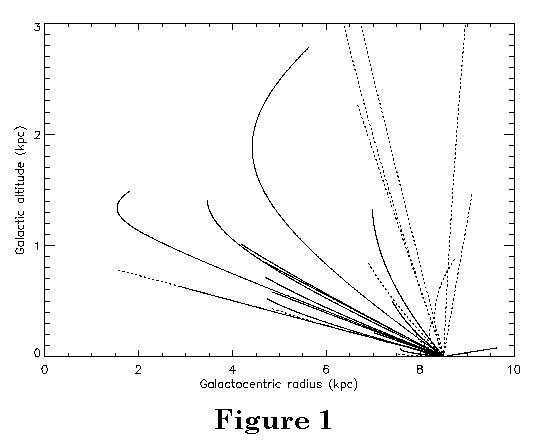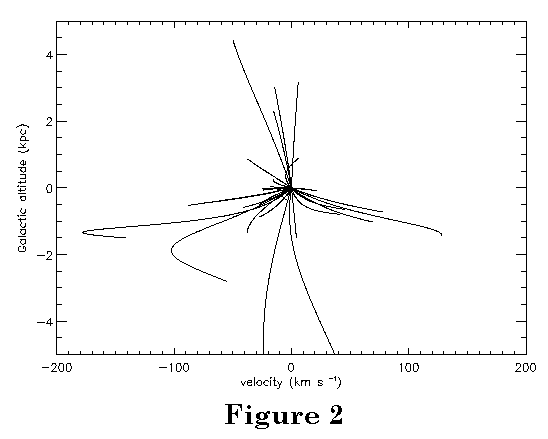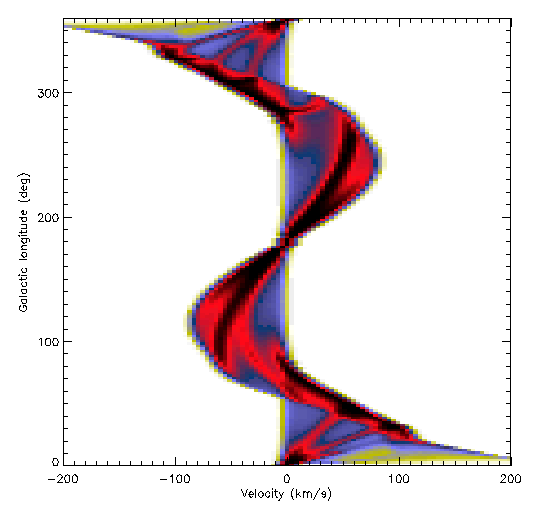



Figures 1 and 2 above display the properties (assuming a co-rotating halo) of the lines of sight toward 30 early type stars in the Galactic halo. Figure 1 shows the paths projected onto the Galactocentric radius - Galactic altitude plane, and Figure 2 shows the expected velocities (due to differential Galactic rotation) along the line of sight as a function of altitude.
Figure 3 (below) displays the absorption for a line of sight with b = 1° and a distance of 10 kpc at different Galactic longitudes (the ordinate) for a hypothetical ion. The distribution of the absorbing gas is a combination of a co-rotating uniformly distributed layer with a scale height of 250 pc, and a set of co-rotating spiral arms with Gaussian scale heights of 300 pc.

My major interest in Galactic halo gas has been in modeling its large scale distribution and motion.
 In collaborated with Savage, I
employed a simplified model of Galactic halo gas and demonstrated that
the gas appears to co-rotate with the disk gas up to a Galactic altitude
of at least 1 kpc. Above that, it may decouple, with the specific
altitude of decoupling depending upon the Galactocentric radius.
In collaborated with Savage, I
employed a simplified model of Galactic halo gas and demonstrated that
the gas appears to co-rotate with the disk gas up to a Galactic altitude
of at least 1 kpc. Above that, it may decouple, with the specific
altitude of decoupling depending upon the Galactocentric radius.
 In additional work with Savage
and Sembach, I developed a somewhat more sophisticated, though still
heuristic, model Galaxy to produce interstellar absorption profiles for
the halo gas and applied them to specific lines of sight. These results
were highly suggestive that the decoupling altitude decreases with
decreasing Galactocentric radius.
In additional work with Savage
and Sembach, I developed a somewhat more sophisticated, though still
heuristic, model Galaxy to produce interstellar absorption profiles for
the halo gas and applied them to specific lines of sight. These results
were highly suggestive that the decoupling altitude decreases with
decreasing Galactocentric radius.
 I have recently begun work in
this field again. My goal is to utilize IUE data for several
halo stars to in order to invert the problem and determine the density
and kinematic behavior of the halo by simultaneously fitting a set of
profiles to a parameterized model galaxy. The Chi square of the fits
is evaluated and the model galaxy parameters are adjusted until an
optimum model is determined. Examples of the improvements which can
result from this approach are given below.
I have recently begun work in
this field again. My goal is to utilize IUE data for several
halo stars to in order to invert the problem and determine the density
and kinematic behavior of the halo by simultaneously fitting a set of
profiles to a parameterized model galaxy. The Chi square of the fits
is evaluated and the model galaxy parameters are adjusted until an
optimum model is determined. Examples of the improvements which can
result from this approach are given below.
 I am also currently involved in an
HST project (PI, Cardelli) which utilizes Galactic rotation
to determine whether a Galactocentric abundance gradient can be
detected. Analysis of these observations is currently underway.
I am also currently involved in an
HST project (PI, Cardelli) which utilizes Galactic rotation
to determine whether a Galactocentric abundance gradient can be
detected. Analysis of these observations is currently underway.
Derck Massa,